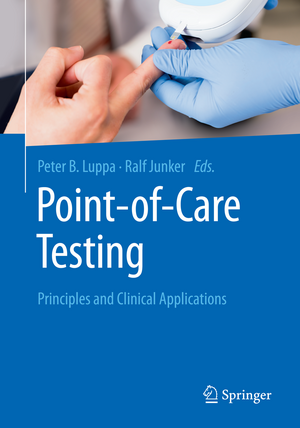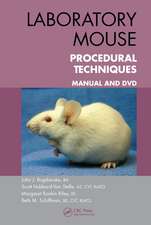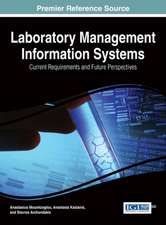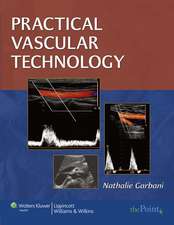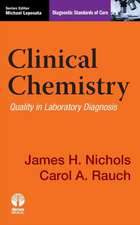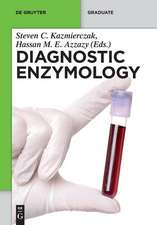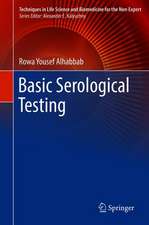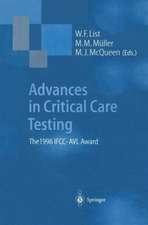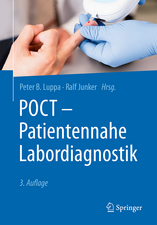Point-of-care testing: Principles and Clinical Applications
Editat de Peter Luppa, Ralf Junkeren Limba Engleză Paperback – 24 iul 2018
Point-of-care testing (POCT) enables health care personnel to perform clinical laboratory testing near the patient.
The idea of conventional and POCT laboratory services presiding within a hospital seems contradictory; yet, they are, in fact, complementary: together POCT and central laboratory are important for the optimal functioning of diagnostic processes. They complement each other, provided that a dedicated POCT coordination integrates the quality assurance of POCT into the overall quality management system of the central laboratory.
The motivation of the third edition of the POCT book from Luppa/Junker, which is now also available in English, is to explore and describe clinically relevant analytical techniques, organizational concepts for application and future perspectives of POCT.
From descriptions of the opportunities that POCT can provide to the limitations that clinician’s must be cautioned about, this book provides an overview of the many aspects that challenge those who choose to implement POCT. Technologies, clinical applications, networking issues and quality regulations are
described as well as a survey of future technologies that are on the future horizon. The editors have spent considerable efforts to update the book in general and to highlight the latest developments, e.g., novel POCT applications of nucleic acid testing for the rapid identification of infectious agents.
Of particular note is also that a cross-country comparison of POCT quality rules is being described by a team of international experts in this field.
Preț: 874.56 lei
Preț vechi: 920.59 lei
-5% Nou
Puncte Express: 1312
Preț estimativ în valută:
167.35€ • 175.08$ • 139.02£
167.35€ • 175.08$ • 139.02£
Carte tipărită la comandă
Livrare economică 31 martie-05 aprilie
Preluare comenzi: 021 569.72.76
Specificații
ISBN-13: 9783662544969
ISBN-10: 3662544962
Pagini: 424
Ilustrații: XXX, 445 p. 100 illus. in color.
Dimensiuni: 168 x 240 x 24 mm
Greutate: 0.73 kg
Ediția:1st ed. 2018
Editura: Springer Berlin, Heidelberg
Colecția Springer
Locul publicării:Berlin, Heidelberg, Germany
ISBN-10: 3662544962
Pagini: 424
Ilustrații: XXX, 445 p. 100 illus. in color.
Dimensiuni: 168 x 240 x 24 mm
Greutate: 0.73 kg
Ediția:1st ed. 2018
Editura: Springer Berlin, Heidelberg
Colecția Springer
Locul publicării:Berlin, Heidelberg, Germany
Cuprins
I. Introduction.- II. Methodology and analytical techniques.- III. Clinical applications.- IV. Legal and organizational framework.- V. Areas of application.-VI. Quality assurance.- VII. Development trends
Notă biografică
Prof. Dr. Peter Luppa, TU Munich, Germany
Prof. Dr. Ralf Junker, University Hospital Kiel, Germany
Textul de pe ultima copertă
The underlying technology and the range of test parameters available are evolving rapidly. The primary advantage of POCT is the convenience of performing the test close to the patient and the speed at which test results can be obtained, compared to sending a sample to a laboratory and waiting for results to be returned. Thus, a series of clinical applications are possible that can shorten the time for clinical decision-making about additional testing or therapy, as delays are no longer caused by preparation of clinical samples, transport, and central laboratory analysis. Tests in a POC format can now be found for many medical disciplines including endocrinology/diabetes, cardiology, nephrology, critical care, fertility, hematology/coagulation, infectious disease and microbiology, and general health screening.
Point-of-care testing (POCT) enables health care personnel to perform clinical laboratory testing near the patient.
The idea of conventional
and POCT laboratory services presiding within a hospital seems contradictory; yet, they are, in fact, complementary: together POCT and central laboratory are important for the optimal functioning of diagnostic processes. They complement each other, provided that a dedicated POCT coordination integrates the quality assurance of POCT into the overall quality management system of the central laboratory. The motivation of the third edition of the POCT book from Luppa/Junker, which is now also available in English, is to explore and describe clinically relevant analytical techniques, organizational concepts for application and future perspectives of POCT.
From descriptions of the opportunities that POCT can provide to the limitations that clinician’s must be cautioned about, this book provides an overview of the many aspects that challenge those who choose to implement POCT. Technologies, clinical applications, networking issues and quality regulations aredescrib
ed as well as a survey of future technologies that are on the future horizon. The editors have spent considerable efforts to update the book in general and to highlight the latest developments, e.g., novel POCT applications of nucleic acid testing for the rapid identification of infectious agents.
Of particular note is also that a cross-country comparison of POCT quality rules is being described by a team of international experts in this field.
Point-of-care testing (POCT) enables health care personnel to perform clinical laboratory testing near the patient.
The idea of conventional
and POCT laboratory services presiding within a hospital seems contradictory; yet, they are, in fact, complementary: together POCT and central laboratory are important for the optimal functioning of diagnostic processes. They complement each other, provided that a dedicated POCT coordination integrates the quality assurance of POCT into the overall quality management system of the central laboratory. The motivation of the third edition of the POCT book from Luppa/Junker, which is now also available in English, is to explore and describe clinically relevant analytical techniques, organizational concepts for application and future perspectives of POCT.
From descriptions of the opportunities that POCT can provide to the limitations that clinician’s must be cautioned about, this book provides an overview of the many aspects that challenge those who choose to implement POCT. Technologies, clinical applications, networking issues and quality regulations aredescrib
ed as well as a survey of future technologies that are on the future horizon. The editors have spent considerable efforts to update the book in general and to highlight the latest developments, e.g., novel POCT applications of nucleic acid testing for the rapid identification of infectious agents.
Of particular note is also that a cross-country comparison of POCT quality rules is being described by a team of international experts in this field.
Caracteristici
Written by experts Comprehensive in scope
